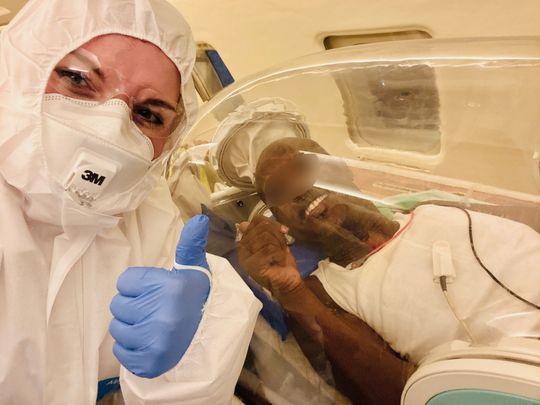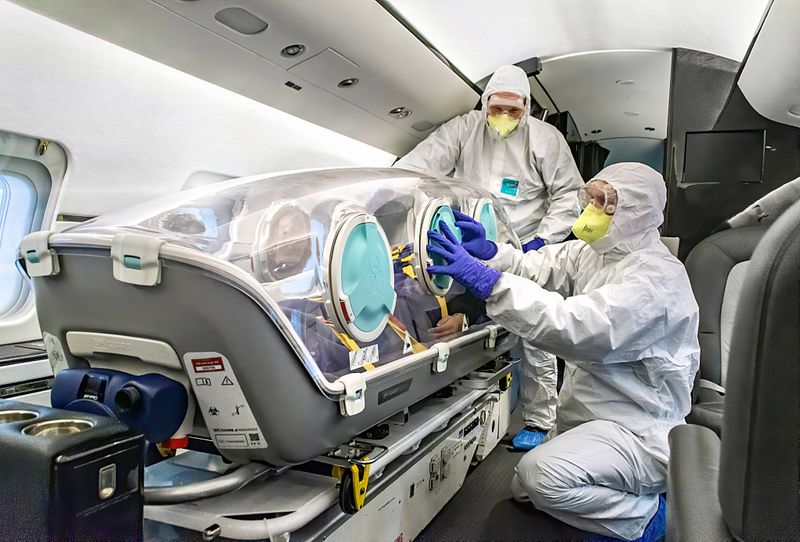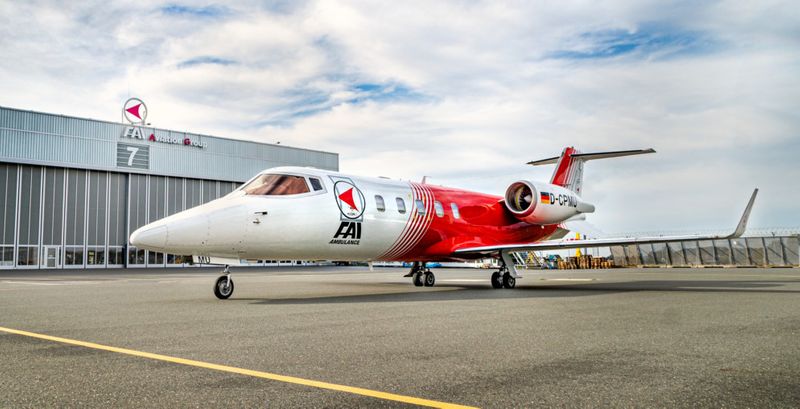
Ever wondered what it’s like to be a nurse flying COVID-19 patients home
UAE resident travels the world transporting coronavirus-stricken patients
by Esha Nag, Property Weekly EditorDubai: Karen James is the girl next door in Abu Dhabi who goes for epic journeys around the world, bringing back home COVID-19 patients from war zones, remote locations and high-risk countries in an isolation unit on board an air ambulance.
“I’m here to take you home,” she tells her patients when she meets them, words that can mean the world to someone on a ventilator.
The 37-year-old British National is a critical-care flight nurse aboard a fully ICU-equipped air-ambulance private jet aircraft. She transports COVID-19 patients on portable isolation unit air ambulance transport missions (called the EpiShuttle) on behalf of governments, international agencies, insurance companies and private clients.

On an EpiShuttle mission
Since the beginning of the Coronavirus pandemic, Karen has clocked on an average more than 25 hours on each EpiShuttle mission, and has been to locations as diverse as Accra, the Canary Islands, Djibouti, Dushanbe, Juba, Kabul, Lagos, London, Marrakesh, Menorca, Mogadishu, Niamey, Pointe Noire, Rabil, Rio de Janeiro, and even the island of Sao Tome off the west coast of Africa. “I have flown over war zones in Afghanistan and high-risk countries such as Somalia… I have frankly lost count,” says Karen.
Her company, FAI rent-a-jet AG, has its fleet based at its headquarters at Albrecht Dürer International Airport in Nuremberg, Germany and operates a branch office in Dubai. It logs more than 10,000 hours per year flying air ambulance missions and typically averages three intercontinental medical evacuations per day for its global client base. The air ambulance division also specialises in air support in hostile areas.
A normal day in Karen’s life with back-to-back missions is nothing like we on the ground can imagine. It involves, for example, flying a patient from UK to Australia, then a pick-up in Korea to the UAE and then maybe again a pick-up in the UAE and a drop off in Spain. “On March 24, I was allocated to a mission from Abu Dhabi and I haven’t been home since then. We have flown patient after patient endlessly during this pandemic and it has been the most challenging getting from point A to B with border closures, restriction of fuel stops and permit issues.”
Complex logistics of flying during COVID-19
The logistics of planning flights, especially in COVID-19 times, with many countries imposing border closures and restrictions, have been more complex than the actual caring of the patient, says Karen. “On many occasions we have not been able to disembark in some countries or perform overnight stays. So, we had to use larger aircraft with more flight crews in order to perform turn-around missions or plan completely different flight routes in order to make an air ambulance flight happen. Some countries even stopped allowing fuel stops which made some missions difficult to execute,” she explains.
Karen moved to the UAE couple of years ago in pursuit of travel and the country seemed a perfect location to fulfil her passion. Her background as an emergency nurse helped her find a job in a trauma centre and then there was an opportunity to become a flight nurse with FAI rent-a-jet AG.

Care for critically ill patients
As a fixed-wing flight nurse on an air ambulance Karen is responsible for providing a bed-to-bed service to her patients. “The patients we transport are usually critically ill, requiring ventilator management, they might even need a special vasoactive medication to stabilise their condition. We assist with the stabilisation of the patient pre-flight. As a flight nurse I have to be prepared for anything, for instance ‘do I have enough oxygen to care for my patient for a period of 20 hours, how much does the patient weigh and how to load a patient inside an aircraft?’. These are critical issues to be considered.”
Karen is proud to have completed many successful COVID-19 missions since March. Her most recent has been transporting an infectious disease doctor, who had saved patients and fellow colleagues in a war-torn country with no ICU facilities to the UK. “The Epishuttle we use to transport patients is a negative pressure chamber. It is designed to provide patient safety while allowing critical care and treatment to be performed. It protects all of us crew as well as airport and ground ambulance staff from an infected patient.”
Quick thinking and team work
Most of the time, the crew on an air ambulance receives COVID-19 positive cases when the patient is at nine to 12 days during the infection and at greatest risk of complications. “There are times when their conditions can deteriorate mid-flight and we feel challenged professionally. It requires a lot of determination, quick thinking and team work between the medical crew on each mission,” says Karen.
“I remember one case where we received a highly critical patient who was not stable at handover at the airport. He was only 21 and had his young family on board the aircraft. The transportation was from the Middle East to Europe, we were on the brink of aborting the mission but we delivered extensive intensive care for more than an hour prior to take-off and managed to stabilise him enough to transport him to Europe for a life-saving operation.”
As part of COVID-19 transportation efforts FAI has also conducted mass scale repatriation of Emirati patients and their family members from Thailand, Korea, India, the US, and Spain; with the majority of patients being children.
Gratitude during a crisis
Despite all the challenges, Karen is filled with gratitude to still be flying during this pandemic with full exposure to Personal Protection Equipment (PPE) and access to medical equipment of the highest standards “My nursing friends globally report increased number of patients to care for with shortages of equipment and PPE supply. I have learnt all I can do is stay positive and hopeful and keep flying.”
Being away from home has been difficult. “I miss my home in Abu Dhabi and my family in the UK, especially my grandmother who is 91 years old,” she says.
“Whenever I touch down in the UAE with a patient, I have to stay in a transit hotel at the airport and depart again with the aircraft. Only once my Tawajudi approval has come through, I can come back to the UAE and stay outside the airport. Living out of a small suitcase, changing overnight accommodation nearly every day and flying around the world without being home in between hasn’t been easy,” admits Karen.

Proud to be a flight nurse
But her strength comes from caring patients at their most vulnerable and in their darkest hours. “It brings a greater perspective of my current situation. I’m proud to call myself a flight nurse during this time and hope I can return home very soon.”
Inside an EpiShuttle
The FAI Air Ambulance works with two portable, self-contained medical isolation units, the EpiShuttle, which allows FAI to transport infected patients without any risk for the flight or medical crew.
These units all have full isolation capability with fully recycled air supply through multiple HEPA filtration systems. They have double port systems with sealed fitted high density glove attachments which let us access the patients without contamination.
The EpiShuttle allows full critical care interventions, so all related equipment, including oxygen supply, ventilator, invasive monitoring for all vital signs and cardiac monitoring is mounted on it, as well as infusion pumps for medications and supportive care. All these devices can access the patient via sealed ports built in to the solid structure of the isolation unit, so the crew can work intensively with the patient without having to break the contamination seal.
Interestingly, for those patients who are awake and alert, there is a two-way radio communication system so they can talk freely with the medical team on board. An EpiShuttle fully transparent so the crew can see the patient at all times, and this gives the patient reassurance and helps overcome any feelings of anxiety or claustrophobia. There are ways to also pass refreshments securely into the unit, so awake patients can maintain their hydration and their nutritionSome patients can also sit up and re-position themselves in an EpiShuttle for maximum comfort.